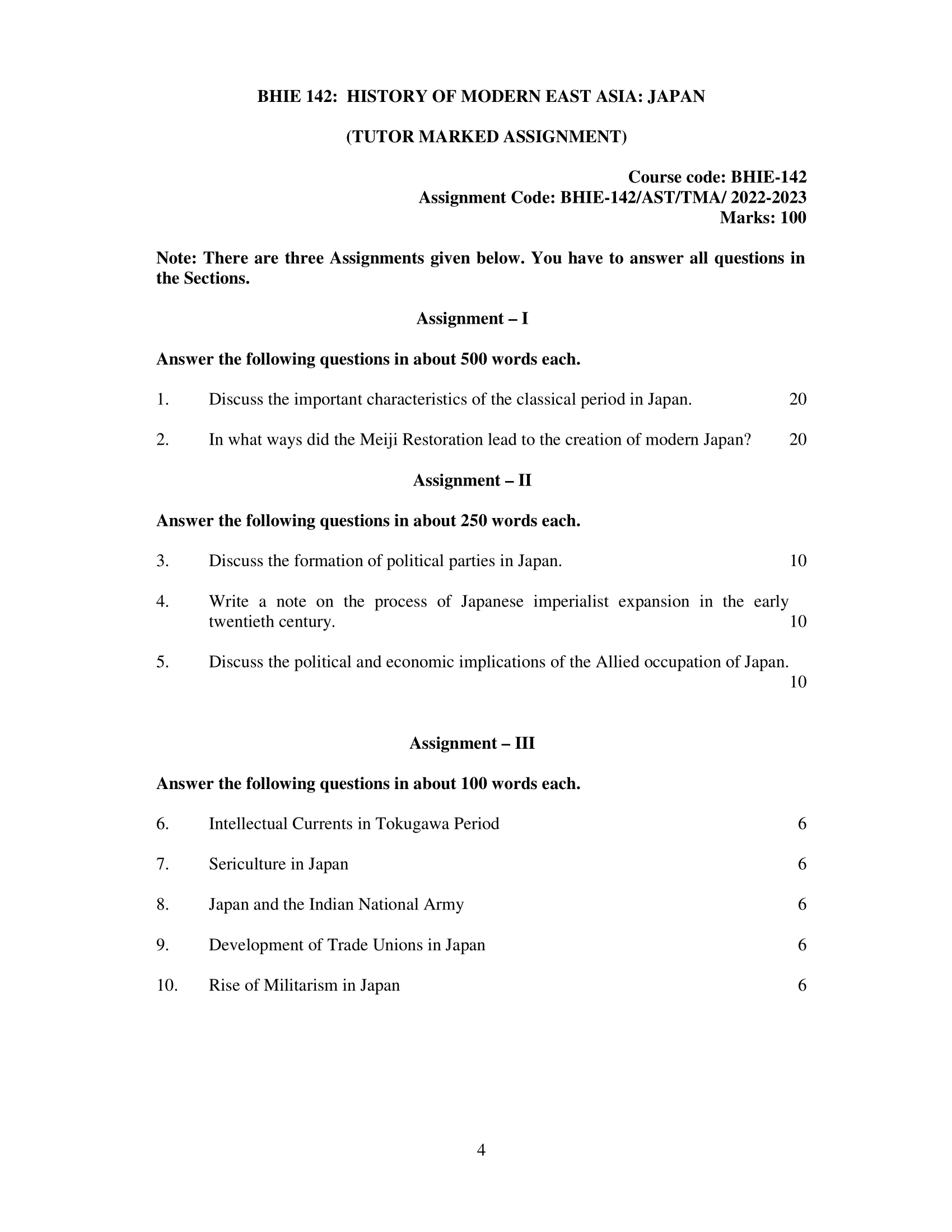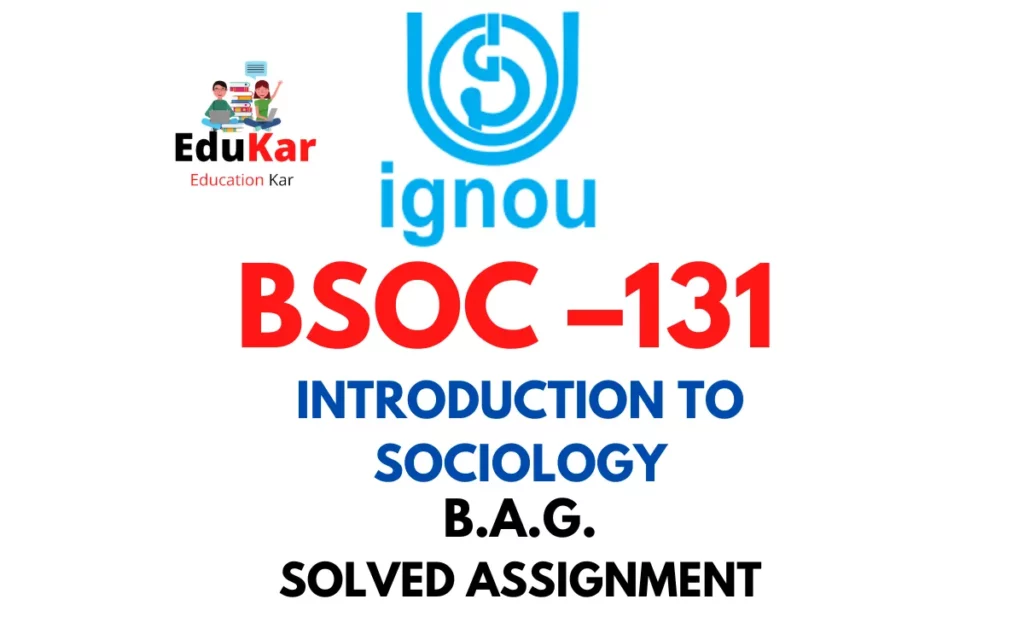Contents
- 1 Assignment – I
- 2 Answer the following questions in about 500 words each.
- 3 1. Discuss the important characteristics of the classical period in Japan.
- 4 2. In what ways did the Meiji Restoration lead to the creation of modern Japan?
- 5 Assignment – II
- 6 Answer the following questions in about 250 words each.
- 7 3. Discuss the formation of political parties in Japan.
- 8 4. Write a note on the process of Japanese imperialist expansion in the early twentieth century.
- 9 5. Discuss the political and economic implications of the Allied occupation of Japan.
- 10 Assignment – III
- 11 Answer the following questions in about 100 words each.
- 12 6. Intellectual Currents in Tokugawa Period.
- 13 7. Sericulture in Japan.
- 14 8. Japan and the Indian National Army.
- 15 9. Development of Trade Unions in Japan.
- 16 10. Rise of Militarism in Japan.

| Title | BHIE-142: IGNOU BAG Solved Assignment 2022-2023 |
| University | IGNOU |
| Degree | Bachelor Degree Programme |
| Course Code | BHIE-142 |
| Course Name | HISTORY OF MODERN EAST ASIA: JAPAN |
| Programme Name | Bachelor of Arts (General) |
| Programme Code | BAG |
| Total Marks | 100 |
| Year | 2022-2023 |
| Language | English |
| Assignment Code | BHIE-142/AST/TMA/ 2022-2023 |
| Last Date for Submission of Assignment: | For June Examination: 31st April For December Examination: 30th September |

Assignment – I
Answer the following questions in about 500 words each.
1. Discuss the important characteristics of the classical period in Japan.
Ans: The classical period in Japan, which lasted from the late 12th century to the late 19th century, saw the rise of several notable cultural and political developments that left a lasting impact on Japanese society. Some of the most important characteristics of this period include:
- Feudalism: The classical period in Japan was marked by a feudal system of government, with powerful lords known as daimyos ruling over their own domains and owing loyalty to the emperor. This period saw the emergence of the samurai class, who served as warriors and protectors for the daimyos.
- Zen Buddhism: The classical period saw the spread of Zen Buddhism, a sect of Buddhism that stressed the importance of meditation and personal enlightenment. Zen Buddhism became especially popular among the samurai class, and had a profound impact on Japanese art, literature, and philosophy.
- Literature and Art: The classical period saw a flowering of Japanese literature and art, with famous works like the Tale of Genji and The Pillow Book being written during this time. Japanese poetry also flourished, with the development of haiku, tanka, and other forms of poetry. The classical period also saw the rise of the ukiyo-e genre of woodblock prints, which depicted scenes from everyday life and the floating world.
- Architecture: The classical period saw the development of several iconic architectural styles, such as shoin-zukuri, which was characterized by tatami mats, sliding doors, and alcoves. The tea ceremony, which emphasized the appreciation of simple beauty and a connection to nature, also became a central part of Japanese culture during this period.
- Political Centralization: Although the classical period was marked by the feudal system, it also saw a gradual centralization of power in the hands of the emperor and the shogun, the military ruler of Japan. This centralization allowed for the development of a strong, centralized government, and helped to maintain stability during a time of political and social upheaval.
- Cultural Exchange: The classical period saw significant cultural exchange between Japan and other countries, especially China and Korea. This exchange brought new ideas, technologies, and styles to Japan, and helped to shape the unique cultural identity of the country.
2. In what ways did the Meiji Restoration lead to the creation of modern Japan?
Ans: The Meiji Restoration, which took place in Japan in 1868, marked a turning point in Japanese history and paved the way for the creation of modern Japan. In the following years, the Japanese government implemented a series of reforms that transformed the country from a feudal society into a modern, industrialized nation. Here are some of the ways in which the Meiji Restoration led to the creation of modern Japan:
- Abolition of the Feudal System: One of the most significant reforms of the Meiji Restoration was the abolition of the feudal system, which had dominated Japanese society for centuries. This allowed for the centralization of power and the formation of a modern, centralized government.
- Modernization of the Economy: The Meiji government implemented a series of reforms aimed at modernizing the economy, including the introduction of modern banking and financial systems, the establishment of joint-stock companies, and the promotion of foreign trade. These reforms helped to stimulate economic growth and lay the foundation for Japan’s rapid industrialization in the late 19th and early 20th centuries.
- Expansion of Education: The Meiji government placed a high priority on education, recognizing its importance for the country’s modernization. The government established a system of public schools and universities, which helped to spread modern ideas and technologies throughout the country.
- Adoption of Western Technologies: In order to catch up with the industrialized countries of Europe and North America, Japan began to adopt Western technologies and ideas in a process known as “Westernization.” This included the introduction of modern technologies, such as steam engines and telegraphs, as well as the adoption of Western legal and political systems.
- Reformation of the Military: The Meiji government also undertook a major reform of the military, creating a modern, centralized army and navy. This helped to establish Japan as a major military power and played a key role in the country’s modernization.
- Emergence of a National Identity: The Meiji Restoration also helped to shape a national identity for Japan, as the country worked to break free from its feudal past and embrace its new role as a modern nation. This process was aided by the promotion of Japanese language and culture, as well as the development of a new constitution in 1889.
Assignment – II
Answer the following questions in about 250 words each.
3. Discuss the formation of political parties in Japan.
Ans: The formation of political parties in Japan can be traced back to the late 19th century, during the Meiji era. The first political parties in Japan were formed in the 1890s, when the country was undergoing rapid modernization and westernization. At that time, there were two main political parties in Japan: the Liberal Party and the Constitutional Democratic Party. These parties were influenced by the ideas of classical liberalism, which emphasized individual rights and limited government.
However, these early political parties were short-lived and were soon replaced by more organized and influential parties. The formation of the Rikken Seiyukai Party in 1900 marked the beginning of a new era in Japanese politics. This party was led by influential figures such as Ito Hirobumi and Takashi Hara, and it was a major player in Japanese politics for several decades.
During the Taisho era (1912-1926), the Rikken Seiyukai Party was challenged by the rise of the Communist Party of Japan. This party was formed in 1922 and was influenced by the ideas of Marxist-Leninism. The Communist Party of Japan was eventually banned in the late 1920s, following the passing of the Public Security Preservation Law.
After World War II, Japan underwent significant political and social reforms, including the adoption of a new constitution in 1947. This constitution emphasized individual rights and limited government, and it laid the foundation for the formation of new political parties. The Liberal Democratic Party was formed in 1955 and quickly became the dominant political force in Japan. This party was dedicated to the idea of creating a strong and prosperous Japan, and it was characterized by its focus on economic development and political stability.
4. Write a note on the process of Japanese imperialist expansion in the early twentieth century.
Ans: The process of Japanese imperialist expansion in the early twentieth century was marked by a series of military conquests and territorial acquisitions. During this period, Japan was seeking to expand its sphere of influence and establish itself as a major world power.
One of the key factors driving Japanese imperialism was the need for raw materials and markets for its rapidly growing economy. Japan was seeking to secure access to resources such as coal, iron, and oil, as well as to expand its trade and investment opportunities.
The first major act of Japanese imperialism took place in 1895, when Japan defeated China in the First Sino-Japanese War. This victory gave Japan control over the Korean Peninsula, which became its first overseas colony. Japan then continued to expand its influence in Asia, acquiring Taiwan in 1895 and several Pacific islands during the early 1900s.
In the early 1910s, Japan was involved in a series of territorial acquisitions in Southeast Asia, including the Philippines, Malaysia, and Indonesia. These conquests were driven by a desire to control vital shipping lanes and secure access to valuable natural resources.
In addition to territorial expansion, Japan also sought to establish itself as a dominant military power in Asia. To this end, it launched a series of military campaigns aimed at suppressing anti-colonial movements and consolidating its control over its newly acquired territories.
The process of Japanese imperialism in the early twentieth century had far-reaching consequences for Asia and the world. Japan’s territorial conquests and military campaigns caused widespread suffering and destabilized the region, ultimately contributing to the outbreak of World War II. At the same time, however, Japan’s rapid rise as a world power also helped to shape the global political and economic landscape, as it challenged the dominance of Western powers in Asia and beyond.
5. Discuss the political and economic implications of the Allied occupation of Japan.
Ans: The Allied occupation of Japan was a period of intense political and economic change in the country, lasting from 1945 to 1952. During this time, Japan was occupied by Allied forces led by General Douglas MacArthur, who was tasked with overseeing the country’s transition to a democratic government and a market-oriented economy.
The Allied occupation had profound political implications for Japan. One of the major changes was the adoption of a new constitution, which was introduced in 1947. This constitution emphasized individual rights and limited government, and it marked a significant departure from the previous political system, which had been dominated by the military and the imperial family.
Another major change was the democratization of Japanese politics. During the occupation, a new political system was established that included the formation of political parties and the holding of free elections. This new system helped to lay the foundation for a vibrant and dynamic democracy that continues to this day.
The Allied occupation also had major economic implications for Japan. One of the key goals of the occupation was to help the country transition from a heavily militarized economy to a market-oriented one. To this end, the Allies implemented a series of reforms aimed at reducing government control over the economy, promoting free trade, and encouraging private enterprise.
One of the most notable reforms was the implementation of a land reform program, which aimed to break up large landholdings and promote the growth of small-scale agriculture. This reform helped to create a more equitable distribution of wealth, and it paved the way for the development of a thriving rural economy.
Assignment – III
Answer the following questions in about 100 words each.
6. Intellectual Currents in Tokugawa Period.
Ans: The Tokugawa period (1603-1868) in Japan was characterized by a thriving intellectual culture, as scholars and thinkers sought to understand and address the challenges facing Japanese society. During this time, several influential intellectual currents emerged, including:
- Confucianism: Confucian ideas were widely studied and debated during the Tokugawa period, as scholars sought to apply the teachings of Confucius to the governance of Japan.
- Nativism: Nativist thought emphasized the importance of Japan’s indigenous culture and traditions, and sought to preserve them in the face of increasing cultural exchange with the outside world.
- Dutch Studies: The study of Dutch learning, including medicine and science, became popular among Japanese intellectuals during the Tokugawa period, as they sought to learn from the advancements of Europe.
- National Learning: National Learning, also known as Kokugaku, was a movement that emphasized the study of classical Japanese literature and culture as a means of understanding the country’s history and traditions.
These intellectual currents helped to shape the intellectual and cultural landscape of Japan during the Tokugawa period, and laid the groundwork for the intellectual ferment of the Meiji period that followed.
7. Sericulture in Japan.
Ans: Sericulture, or the cultivation of silkworms for the production of silk, has a long history in Japan dating back to the Nara period (710-794). During the Tokugawa period (1603-1868), sericulture became an important industry in Japan, and the production of silk was carefully regulated by the government. In addition to its economic significance, sericulture was also seen as a symbol of Japan’s cultural heritage and was often practiced by samurai and other members of the upper classes. Today, Japan continues to be a major producer of silk, and the traditional techniques of sericulture are still practiced in many parts of the country. The preservation of this cultural tradition is seen as an important part of Japan’s national heritage, and efforts are underway to promote and protect this unique aspect of Japan’s cultural heritage.
8. Japan and the Indian National Army.
Ans: The Indian National Army (INA) was a military force composed of Indian prisoners of war and Indian expatriates in Southeast Asia, formed during World War II with the goal of securing independence for India from British rule. The INA received support from the Japanese government, which saw the INA as a means of disrupting British colonial rule in India and strengthening its own position in Southeast Asia. During the war, the INA fought alongside Japanese forces in Burma and India, but ultimately failed to achieve its goal of securing independence for India. Nevertheless, the INA’s role in the war had a lasting impact on the independence movement in India, and its leaders, including Subhas Chandra Bose, became national heroes and symbols of the struggle for independence. The INA’s legacy continues to be remembered and celebrated in India, and its role in the independence movement is widely regarded as an important part of India’s national heritage.
9. Development of Trade Unions in Japan.
Ans: The development of trade unions in Japan began in the late 19th century and gained momentum in the early 20th century. During this time, workers in Japan were seeking to improve their working conditions and to secure better wages and benefits. The first trade unions were formed by workers in the textile and mining industries, and they gradually spread to other sectors of the economy. The growth of trade unions was accompanied by a series of strikes and labor disputes, as workers sought to assert their rights and to improve their standard of living. Over time, trade unions became an important political force in Japan, and they played a key role in shaping the country’s labor laws and policies. Today, trade unions continue to be a significant part of the Japanese labor landscape, representing the interests of millions of workers and advocating for workers’ rights and fair treatment in the workplace.
10. Rise of Militarism in Japan.
Ans: The rise of militarism in Japan was a gradual process that began in the late 19th century and accelerated in the early 20th century. It was driven by a number of factors, including the desire to establish Japan as a major world power, to secure access to resources and markets, and to assert military dominance over Asia. The military gradually gained more influence over the government and the imperial family, and it came to play a dominant role in shaping Japan’s domestic and foreign policies. This led to a series of territorial conquests and military campaigns, which ultimately contributed to the outbreak of World War II and Japan’s defeat in 1945. The rise of militarism had far-reaching consequences for Japan and the world, and it remains a significant chapter in the country’s modern history.
How to Download BHIE-142 Solved Assignment?
You can download it from the www.edukar.in, they have a big database for all the IGNOU solved assignments.
Is the BHIE-142 Solved Assignment Free?
Yes this is absolutely free to download the solved assignment from www.edukar.in
What is the last submission date for BHIE-142 Assignment?
For June Examination: 31st April, For December Examination: 30th October















